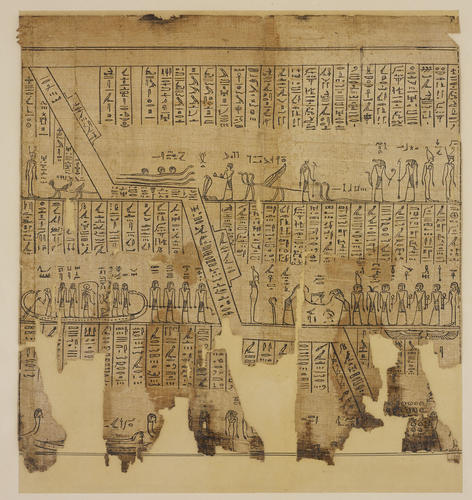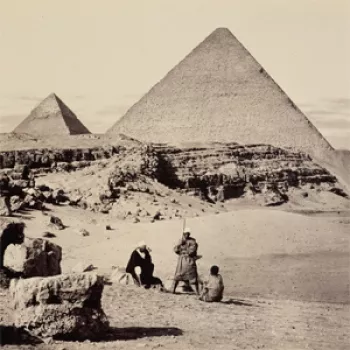Section of the papyrus belonging to Nesmin, with the fourth hour of the Amduat c.300-275 BC
61.5 x 80.5 cm (mount) (whole object) | RCIN 1145263
-
Section of the papyrus belonging to ‘God’s Father and Prophet of Amun-Ra, King of the Gods, Nesmin, born of the Lady of the House, Sistrum-player of Amun-Ra, Tasherit(en-ta)ihet’ with the fourth hour of the Amduat (see also RCINs 1145259-64).
The Amduat (literally ‘that which is in the netherworld’), also known as the Book of the Hidden Chamber, is a funerary text that describes the journey of regeneration of Ra, the Egyptian sun god, through the 12 hours of the night from sunset (symbolising death) to sunrise (symbolising rebirth). The text starts appearing in royal tombs from around 1500 BC, and the two most notable examples are perhaps those painted on the walls of the burial chambers of Thutmose III (1479–1425 BC) and Amenhotep II (1427–1400 BC) in the Valley of the Kings, Thebes. It represents an important stepping stone in the literary tradition of ancient Egypt, being the model for later Books of the Afterlife, and it maintains its relevance well into the Graeco-Roman era.
The main aim of the text is to offer a description of the netherworld so that the deceased, as well as the living, are able to gain familiarity with what to expect when their journey into the afterlife begins. Knowledge of the secret paths of the netherworld offers protection to the deceased from the dangers and threats he/she may encounter; the text shows the obstacles and demons that could obstruct a safe passage through the hereafter as well as the deities and beings able to assist and help the deceased towards the completion of the journey of regeneration.
In the fourth hour of the Amduat, Ra enters a dark and dry new region called Rosetau, meaning 'act of towing'. His solar bark is indeed depicted as being towed by four gods over a dry, sandy land populated by snakes. The solar barque (Mesektet) itself has been transformed into a double-headed serpent as only snakes can successfully get across this desert and dangerous region. The zigzag path, repeatedly closed by doors, gives access to the 'Land of Seker, who is upon his sand', which Ra visits during the fourth and fifth hours. Seker was originally a falcon-headed god of death worshipped in the Memphis area, equated, from the New Kingdom, with Osiris.
The central scene of the middle register is represented by Thoth offering the sacred eye to Seker-Osiris. Thoth was the ibis-headed god of writing and wisdom, who helped Horus in his conflict against Set to avenge the death of Osiris, Horus's father. According to some versions of the myth, during one of the battles, Horus loses one of his eyes, which is later healed and restored by Thoth (or Hathor, according to other versions). In this case, the sacred eye is called the 'eye of Seker' and, like the 'eye of Horus', is a symbol of light which is needed to successfully cross this dark region. The theme of light is also present on the right-hand side of the lower register where, possibly over a depiction of the nocturnal sky, the winged sun-disc, called here Khepri, is represented. Khepri, whose symbol is the scarab beetle, is the rejuvenated morning form of the sun god and he is placed here to renew the promise of new light at the end of the journey of transformation through the dark regions of the netherworld.
Egyptologist Samuel Birch published his study of the papyrus in 1863 (RCIN 1079232). A facsimile was published in 1913 with the hieroglyphic transcripts, translations and an introduction by E.A. Wallis Budge.
A more recent English translation of the complete text of the Amduat can be found in Hornung, E and Abt, T eds, 2007. The Egyptian Amduat. The Book of the Hidden Chamber. Zurich: Living Human Heritage, while a psychological interpretation of the text is presented in Schweizer, A, 2010. The Sungod’s Journey through the Netherworld. Reading the Ancient Egyptian Amduat. Ithaca, NY and London: Cornell University Press.
Provenance
Excavated in Egypt at the Dra' Abu el-Naga' necroplis, near Deyr el-Bahri, part of the larger Theban necropolis, 1862 by Mustafa Aga Ayad, consular agent to the United Kingdom. Acquired by King Edward VII, when Prince of Wales, during his 1862 tour of the Middle East.
-
Measurements
61.5 x 80.5 cm (mount) (whole object)
38.7 x 37.7 cm (sheet of paper)
86.5 x 67.0 cm (book in box)
Category
Alternative title(s)
Passage of the sun through an hour of the night ; 5. (Papyrus of Nas-Khem Priest of Amen-Ra).











